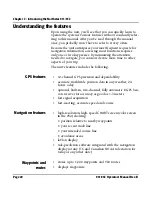
Chapter 2 - Introducing the Northstar 951/952
951/952 Operator’s Manual Rev. B
Page 25
Comparing GPS and loran
The nation’s GPS system was developed by the United States
Department of Defense (DOD) and comprises 21 active satel-
lites (with three additional spares) that literally encircle the
earth with navigation information. The major advantage of
GPS over all other commercially available navigation systems—
including loran—is its all-weather, worldwide availability and
absolute accuracy.
Absolute accuracy
refers to the ability of a
navigation device to determine your actual latitude and longi-
tude coordinates on the surface of the earth, as compared to
position information determined from a chart or other refer-
ence.
Repeatable accuracy
refers to the ability to return to a
position whose coordinates you’ve previously recorded with
the same equipment. GPS has an absolute and repeatable
accuracy of 20 to 30 meters (better than 100 feet) 95 percent
of the time, according to the U.S. government. This means that
you can expect to be within 100 feet of your intended position
95 percent of the time, and beyond that area approximately
five percent of the time.
Selective availability
The Department of Defense developed a system of built-in
errors, called Selective Availability (SA), which was introduced
as a national defense strategy to intentionally degrade the GPS
solution. (The DOD wanted to avoid the possibility that its pre-
cision could be used by hostile forces as a source of accurate
targeting data against U.S. interests.) When it was enabled, SA
reduced GPS’s absolute and repeatable accuracy from a maxi-
mum of 30 meters (better than 100 feet) 95 percent of the
time, to 100 meters (better than 330 feet) 95 percent of the
time. However, this accuracy didn’t meet the Coast Guard’s
requirement of 8-20 meters for navigating in harbors, so the
Coast Guard developed a system of differential corrections, or
differential GPS (DGPS)
to allow them to effectively circum-
vent SA’s built-in errors. SA was officially ended early in the
year 2000, but the advantage of using DGPS over non-SA GPS
is still clear and desirable for the safety of marine navigation.
Mariners who need better than 100 meters probably will also
need better than 30 meters.
Summary of Contents for 951
Page 6: ...Page iv 951 952 Operator s Manual Rev B ...
Page 8: ...Page vi 951 952 Operator s Manual Rev B ...
Page 10: ...Page viii 951 952 Operator s Manual Rev B ...
Page 24: ...Page 14 951 952 Operator s Manual Rev B Chapter 1 Quick Start ...
Page 40: ...Page 30 951 952 Operator s Manual Rev B Chapter 2 Introducing the Northstar 951 952 ...
Page 50: ...Page 40 951 952 Operator s Manual Rev B Chapter 3 Using the Controls ...
Page 124: ...Page 114 951 952 Operator s Manual Rev B Chapter 7 Creating Routes ...
Page 136: ...Page 126 951 952 Operator s Manual Rev B Chapter 8 Understanding Waypoint Route Navigation ...
Page 154: ...Page 144 951 952 Operator s Manual Rev B Chapter 10 Using Other Special Functions ...
Page 184: ...Page 174 951 952 Operator s Manual Rev B Chapter 11 Customizing the Unit ...
Page 188: ...Page 178 951 952 Operator s Manual Rev B ...














































